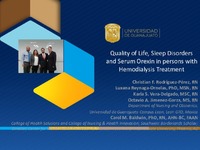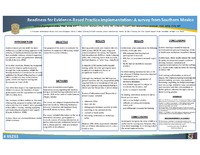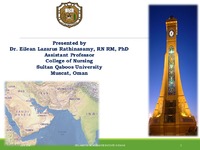| dc.contributor.author | Reynaga-Ornelas, Luxana | en |
| dc.contributor.author | Rodriguez-Perez, Christian F. | en |
| dc.contributor.author | Vera-Delgado, Karla Susana | en |
| dc.contributor.author | Jimenez-Garza, Octavio A. | en |
| dc.contributor.author | Baldwin, Carol M. | en |
| dc.date.accessioned | 2016-03-17T12:58:01Z | |
| dc.date.available | 2016-03-17T12:58:01Z | |
| dc.date.issued | 2016-03-17 | |
| dc.identifier | INRC15M06 | en |
| dc.identifier.uri | http://hdl.handle.net/10755/601880 | en |
| dc.description | <p>Research Congress 2015 Theme: Question Locally, Engage Regionally, Apply Globally. Held at the Puerto Rico Convention Center.</p> | en |
| dc.description.abstract | <p><strong>Purpose:</strong> The evaluation of the patients' health-related quality of life (HRQOL) represents the impact of the disease and its subsequent treatment on the perception of the their own wellness. The purpose of this study was ti examin the relationship between HRQOL, sleep disorders and serum levels of orexin.</p>
<p><strong>Methods:</strong> This analytical study included 39 adults in renal replacement therapy (hemodialysis ) who signed the informed consent for participation. KDQOLSF -36 questionnaire and sleep habits questionnaire (SHHS) were used. Blood samples were taken for determination of orexin levels and analyzed by enzyme immunoassay technique (EIA). Data was captured and analyzed with the SPSS statistics package version18. Results are reported as means, standard deviations and percentages. The Pearson correlation test was used to analyze associations between the study variables and HRQOL scores.</p>
<p><strong>Results:</strong> HRQOL scores were lower in the dimensions of physical role and emotional role of SF-36 KDQOL as resulting in 28.8 and 29 respectively on a scale from 0 to 100 where the higher the score, the better CV perceived. In the subscales that comprise the physical component of HRQOL (PCS) the score was 40.3 and 42.9 in the mental component (MCS). HRQOL related to kidney disease and its treatment was more affected in the burden of disease and employment dimenisons (scores of 38.5 and 39.7 respectively). Sleep disorders more frequently reported were: light sleep (36%), restless sleep (28%), snoring (56%), sense of urgency to move the legs (53%), daytime sleepiness (23%) and insomnia (30%). Negative correlations were found between the physical component score of HRQOL and minutes taken to sleep (r=-.423; p =,007), difficulty to stay asleep (r=-.482; p=,002), waking up at night and having difficulty to go back to sleep (r=-.437; p=0.005), feeling sleepy during the day (r=.525; p=,001), stoping breathing during sleep (r=-.578; p=.000). Negative correlations were also found between the mental component score of HRQOL and minutes taken to sleep (r=-.410; p=.008) and between quality of sleep (movement) and serum orexin (r=-. 363; p=,023). Positive correlations were found between the physical component of HRQOL and the quality of sleep (0-10)(r=.563; p=.000), quality of sleep (profundidad)(r=.322, p=.046), the mental component of HRQOL and quality of sleep (0-10) (r=.497; p=.001) and minutes to fall asleep with serum orexins (r =.407 p=,010).</p>
<p><strong>Conclusion:</strong> Sleep disorders are related with lower scores of perceived HRQOL. Serum orexin levels are related with reported sleep disorders in Mexicans with hemodialysis. No relationship was found between HRQOL and serum orexins. The role of orexins in sleep disorders reported by persons with hemodialysis treatment needs to be investigated in further studies.</p> | en |
| dc.format | Text-based Document | en |
| dc.language.iso | en | en |
| dc.subject | Quality of Life | en |
| dc.subject | Sleep Disorders | en |
| dc.subject | Hemodialysis | en |
| dc.title | Quality of life, sleep disorders and serum orexin in persons with hemodialysis treatment | en |
| dc.title.alternative | Issues that affect patients' quality of life | en |
| dc.type | Presentation | en |
| dc.rights.holder | <p>
All rights reserved by the author(s) and/or publisher(s) listed in this item record unless relinquished in whole or part by a rights notation or a Creative Commons License present in this item record.
</p><p>
All permission requests should be directed accordingly and not to the Sigma Repository.
</p><p>
All submitting authors or publishers have affirmed that when using material in their work where they do not own copyright, they have obtained permission of the copyright holder prior to submission and the rights holder has been acknowledged as necessary.
</p> | en |
| dc.description.note | <p>Items submitted to a conference/event were evaluated/peer-reviewed at the time of abstract submission to the event. No other peer-review was provided prior to submission to the Henderson Repository.</p> | en |
| dc.type.category | Full-text | en |
| dc.evidence.level | N/A | en |
| dc.research.approach | N/A | en |
| dc.contributor.department | Beta Upsilon | en |
| dc.author.details | Luxana Reynaga-Ornelas; Christian F. Rodriguez-Perez, RN; Karla S. Vera-Delgado, RN; Octavio A. Jimenez-Garza, RN; Carol M. Baldwin, RN, AHN-BC, FAAN | en |
| dc.conference.name | 26th international Nursing Research Congress | en |
| dc.conference.host | Sigma Theta Tau International | en |
| dc.conference.location | San Juan, Puerto Rico | en |
| dc.date.conferenceyear | 2015 | |
| dc.description.reviewtype | Abstract Review Only: Reviewed by Event Host | en |
| dc.description.acquisition | Proxy-submission | en |





